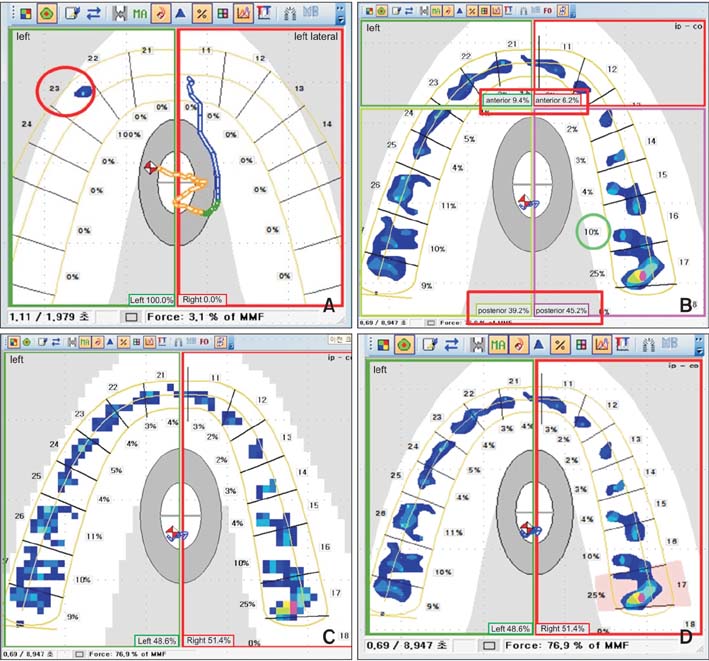Korean J Orthod.
2016 Jan;46(1):27-35. 10.4041/kjod.2016.46.1.27.
Computerized occlusal analysis: correlation with occlusal indexes to assess the outcome of orthodontic treatment or the severity of malocculusion
- Affiliations
-
- 1Department of Orthodontics, College of Dentistry, Dankook University, Cheonan, Korea. leesm0624@dankook.ac.kr
- KMID: 2152895
- DOI: http://doi.org/10.4041/kjod.2016.46.1.27
Abstract
OBJECTIVE
The aims of our study were to verify the validity of the T-Scan III system (Tekscan) as an objective occlusal evaluation tool, and to assess the differences between two occlusal indexes-the peer assessment rating (PAR) index and the American Board of Orthodontics objective grading system (OGS)-by comparing the scores derived from the T-Scan III system with the two occlusal indexes and analyzing the correlations between them.
METHODS
The final study sample included 48 adult volunteers (39 men and 9 women, mean age 24.14 +/- 3.16 years), after excluding 29 volunteers whose occlusion could not be evaluated by the T-Scan III system due to severe skeletal or occlusal problems. PAR index and OGS scores were assessed using dental study models, and measurements of centric occlusion, protrusive movement, and lateral excursion movement were obtained via the T-Scan III system. The results were analyzed to determine correlations.
RESULTS
Occlusal analysis by the T-Scan III system was clinically reliable (p < 0.05), and the PAR index and OGS scores were significantly correlated with several measurements obtained with the T-Scan III system (p < 0.05).
CONCLUSIONS
The T-Scan III system is a quantitative and reliable method for occlusal evaluation, and represents a potential substitute for occlusal indexes. Compared to the PAR index, the OGS scores of more variables were significantly correlated with the T-Scan measurements.
MeSH Terms
Figure
Cited by 1 articles
-
The Improvement and Completion of Outcome index: A new assessment system for quality of orthodontic treatment
Mihee Hong, Yoon-Ah Kook, Myeng-Ki Kim, Jae-Il Lee, Hong-Gee Kim, Seung-Hak Baek
Korean J Orthod. 2016;46(4):199-211. doi: 10.4041/kjod.2016.46.4.199.
Reference
-
1. Eismann D. Reliable assessment of morphological changes resulting from orthodontic treatment. Eur J Orthod. 1980; 2:19–25.
Article2. Berg R. Post-retention analysis of treatment problems and failures in 264 consecutively treated cases. Eur J Orthod. 1979; 1:55–68.
Article3. Casko JS, Vaden JL, Kokich VG, Damone J, James RD, Cangialosi TJ, et al. Objective grading system for dental casts and panoramic radiographs. American Board of Orthodontics. Am J Orthod Dentofacial Orthop. 1998; 114:589–599.4. Richmond S, Shaw WC, O'Brien KD, Buchanan IB, Jones R, Stephens CD, et al. The development of the PAR Index (Peer Assessment Rating): reliability and validity. Eur J Orthod. 1992; 14:125–139.
Article5. Hamdan AM, Rock WP. An appraisal of the Peer Assessment Rating (PAR) Index and a suggested new weighting system. Eur J Orthod. 1999; 21:181–192.
Article6. Deguchi T, Honjo T, Fukunaga T, Miyawaki S, Roberts WE, Takano-Yamamoto T. Clinical assessment of orthodontic outcomes with the peer assessment rating, discrepancy index, objective grading system, and comprehensive clinical assessment. Am J Orthod Dentofacial Orthop. 2005; 127:434–443.
Article7. Throckmorton GS, Rasmussen J, Caloss R. Calibration of T-Scan sensors for recording bite forces in denture patients. J Oral Rehabil. 2009; 36:636–643.
Article8. Maness WL, Benjamin M, Podoloff R, Bobick A, Golden RF. Computerized occlusal analysis: a new technology. Quintessence Int. 1987; 18:287–292.9. Koos B, Godt A, Schille C, Göz G. Precision of an instrumentation-based method of analyzing occlusion and its resulting distribution of forces in the dental arch. J Orofac Orthop. 2010; 71:403–410.
Article10. Kerstein RB, Wright NR. Electromyographic and computer analyses of patients suffering from chronic myofascial pain-dysfunction syndrome: before and after treatment with immediate complete anterior guidance development. J Prosthet Dent. 1991; 66:677–686.
Article11. Dahlberg G. Statistical methods for medical and biological students. London: G Allen & Unwin Ltd;1940. p. 1–140.12. Wang YL, Cheng J, Chen YM, Yip KH, Smales RJ, Yin XM. Patterns and forces of occlusal contacts during lateral excursions recorded by the T-Scan II system in young Chinese adults with normal occlusions. J Oral Rehabil. 2011; 38:571–578.
Article13. Garrido García VC, García Cartagena A, González Sequeros O. Evaluation of occlusal contacts in maximum intercuspation using the T-Scan system. J Oral Rehabil. 1997; 24:899–903.
Article14. Mizui M, Nabeshima F, Tosa J, Tanaka M, Kawazoe T. Quantitative analysis of occlusal balance in intercuspal position using the T-Scan system. Int J Prosthodont. 1994; 7:62–71.15. Richmond S, Shaw WC, O'Brien KD, Buchanan IB, Jones R, Stephens CD, et al. The development of the PAR Index (Peer Assessment Rating): reliability and validity. Eur J Orthod. 1992; 14:125–139.
Article16. Fox NA. The first 100 cases: a personal audit of orthodontic treatment assessed by the PAR (peer assessment rating) index. Br Dent J. 1993; 174:290–297.
Article17. McGorray SP, Wheeler TT, Keeling SD, Yurkiewicz L, Taylor MG, King GJ. Evaluation of orthodontists' perception of treatment need and the peer assessment rating (PAR) index. Angle Orthod. 1999; 69:325–333.18. Onyeaso CO, Begole EA. Relationship between index of complexity, outcome and need, dental aesthetic index, peer assessment rating index, and American Board of Orthodontics objective grading system. Am J Orthod Dentofacial Orthop. 2007; 131:248–252.
Article19. Murakami K, Deguchi T, Hashimoto T, Imai M, Miyawaki S, Takano-Yamamoto T. Need for training sessions for orthodontists in the use of the American Board of Orthodontics objective grading system. Am J Orthod Dentofacial Orthop. 2007; 132:427.e1–427.e6.
Article
- Full Text Links
- Actions
-
Cited
- CITED
-
- Close
- Share
- Similar articles
-
- A study on the occlusal plane inclination in lateral cephalograph
- Comparison of two computerized occlusal analysis systems for indicating occlusal contacts
- Effects of a new type of clear overlay retainer on occlusal contacts
- Occlusal force evaluation and its clinical implication in dental clinics
- Roentgenocephalometric study on facial height and occlusal plane inclination in Class I malocclusion group



